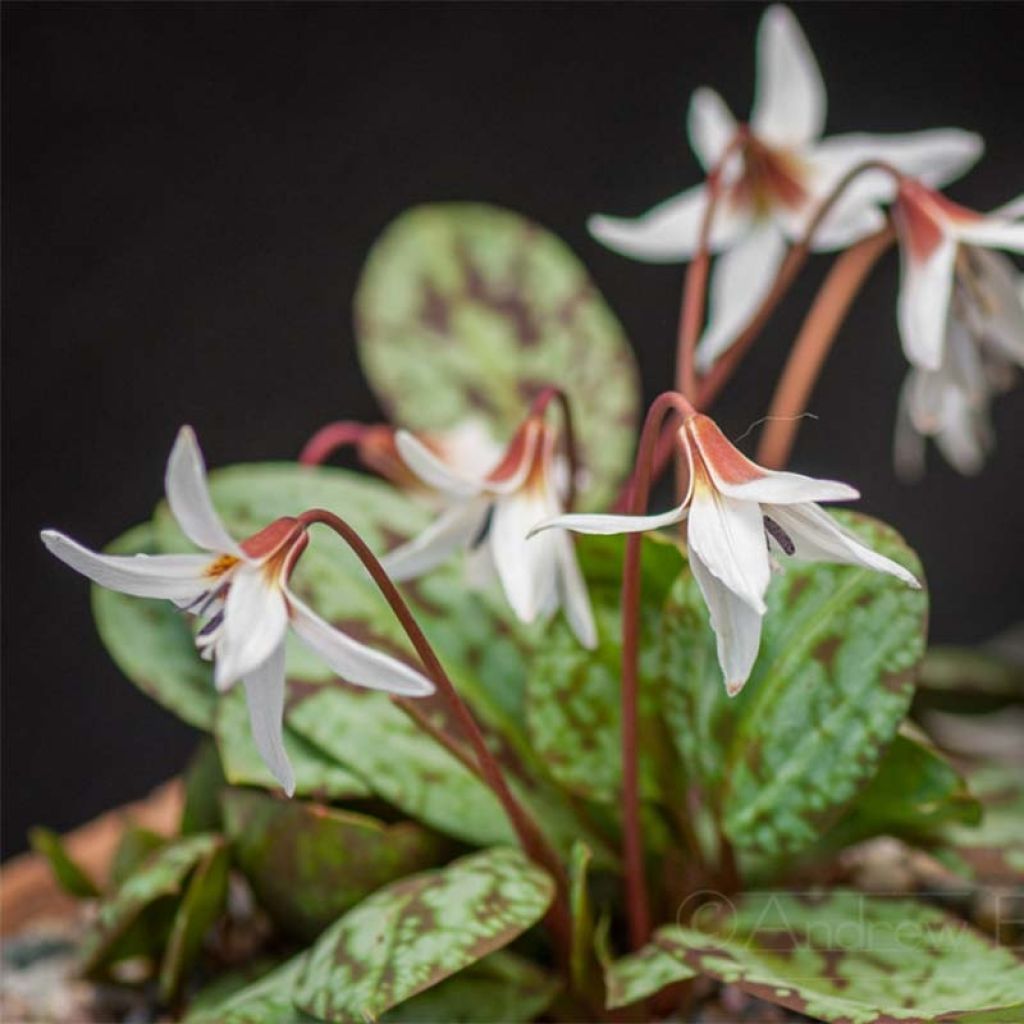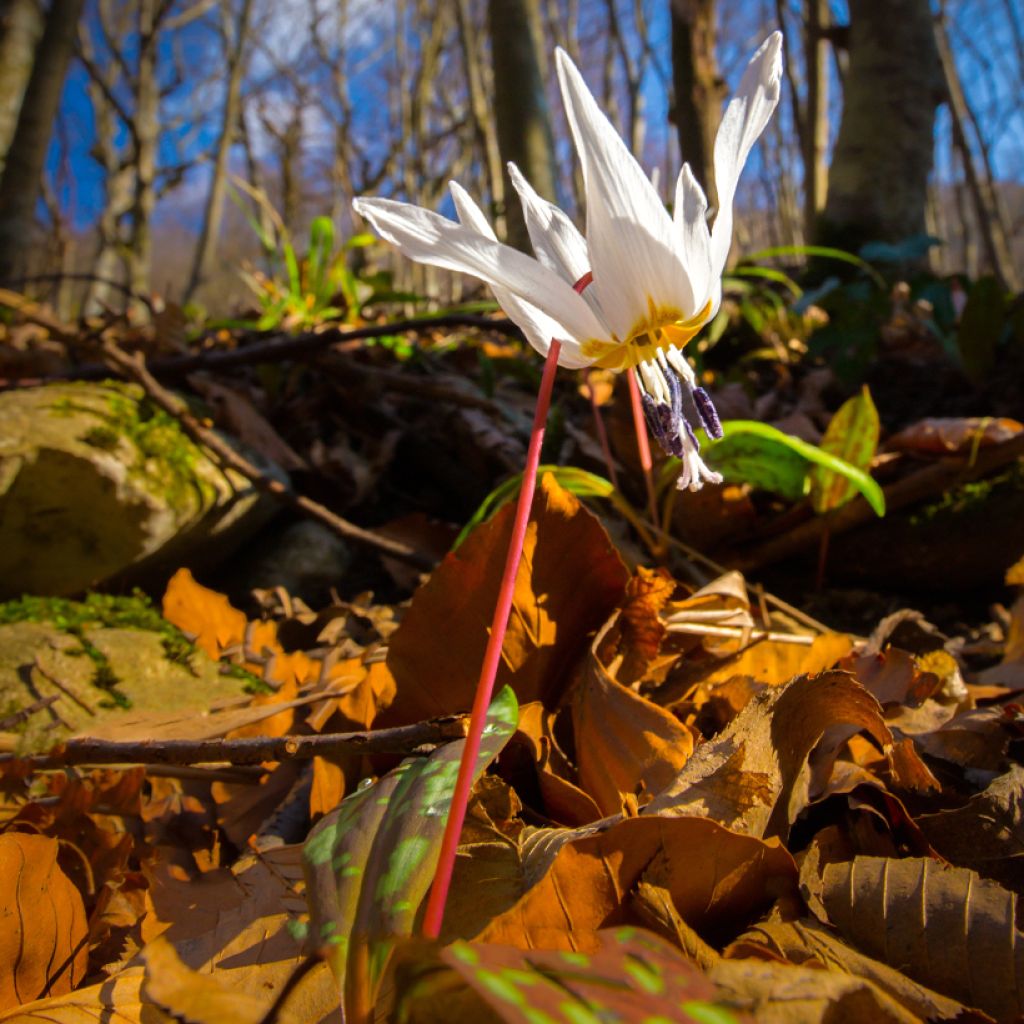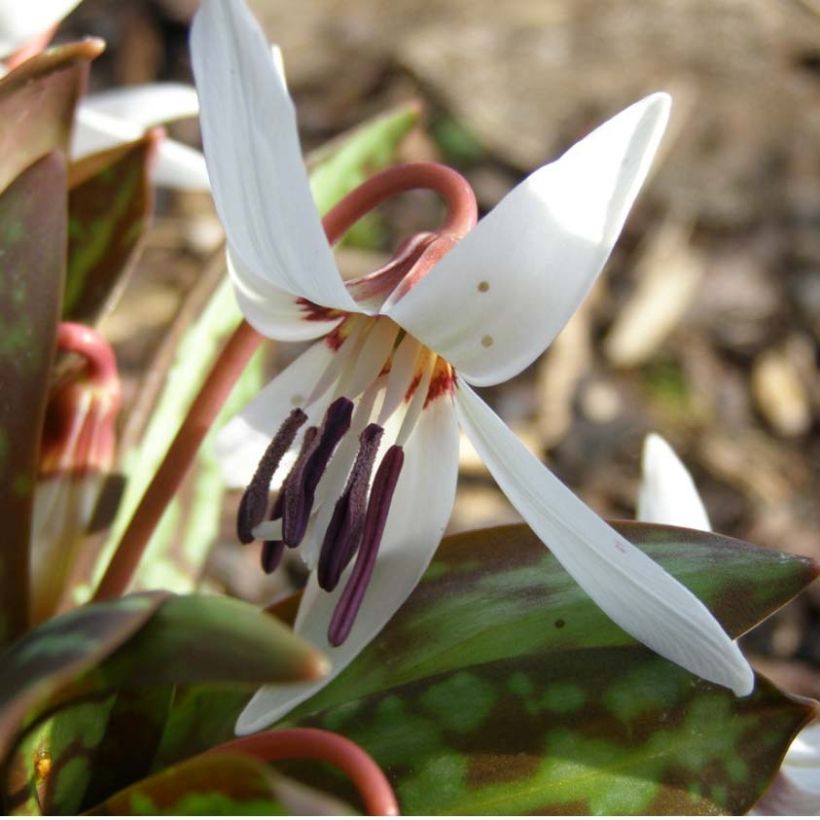

Erythronium dens canis Snowflake - Erythrone dent de chien


Erythronium dens canis Snowflake


Erythronium dens canis Snowflake
Erythronium dens-canis Snowflake
Erythronium dens canis Snowflake
Dog's tooth Violet
This plant carries a 6 months recovery warranty
More information
We guarantee the quality of our plants for a full growing cycle, and will replace at our expense any plant that fails to recover under normal climatic and planting conditions.
From €5.90 for pickup delivery and €6.90 for home delivery
Express home delivery from €8.90.

Does this plant fit my garden?
Set up your Plantfit profile →
Description
Erythronium dens-canis 'Snowflake' is a small bulbous plant native to the clear undergrowth of mountainous areas. It is little known to modern gardeners, despite its charm and cold resistance. It boasts a bright and delicate spring flowering, which takes the form of pendulous white flowers with violet stamens, tinged with purple and yellow in the throat. It is even more spectacular when planted in groups, or with other spring bulbs or perennials. To succeed in its cultivation, plant it in partial shade, in humus-rich, well-draining soil that is not too dry.
Erythronium dens-canis belongs to a genus that includes about 27 species distributed worldwide. All these plants belong to the Liliaceae family, just like lilies. They are from the undergrowth and thrive in humiferous, rich, light, moist but not waterlogged, acidic, neutral or not excessively calcareous soils. Erythronium dens-canis, of European mountain origin, does not appreciate heatwaves or long dry summers.
'Snowflake' is a little slow to establish and its bulb does not like to be disturbed or kept dry for too long. In spring, the plant forms two leaves from which a flower stem emerges. The stem will not exceed 15cm (6in) in height. The somewhat soft and 'fleshy' thick leaves are ovate to oblong in shape, lanceolate, and sheathing at the base. The glaucous green lamina is shiny and somewhat marbled with purple or brown. In March-April, reddish-brown flower stems appear, each carrying a solitary flower hanging towards the ground, with 6 recurved petals, revealing 6 long violet anthered stamens. The white bulb is cylindrical, pointed and curved at one end, somewhat like a large canine tooth. For this reason, erythroniums are sometimes called 'dog's teeth'. The foliage dries up during summer, which corresponds to the bulb's resting period. The flowering is followed by the formation of small black and ochre seeds that will be exclusively dispersed by ants.
Due to the disturbance of its habitat, and perhaps also the covetousness of rare plant enthusiasts, this dog's tooth violet has become quite rare in nature. It has given rise to beautiful horticultural forms, such as 'Snowflake', which are quite difficult to find in commerce. The bulbs are only available for a very short period. It is a charming plant, which you should plant as soon as you receive your order, as the bulbs do not like to be out of the ground for too long. It is an undemanding plant that settles quietly in the garden and naturalises when its happy. It is best to leave the bulbs in place. They will flower for many years if you provide them with a place in the undergrowth, under deciduous trees, or near an east-facing wall, in soil that does not excessively dry out. In summer, a layer of straw will prevent water evaporation and maintain a slight humidity. Plant 'Snowflake' with wood hyacinths (Scilla nutans), Anemone blanda or A. coronaria, liverworts, primroses or ranunculus that appreciate the same environments. You can also plant the bulbs in a pot, keeping the substrate always slightly moist, even in summer when the plant is dormant.
Report an error about the product description
Erythronium dens-canis Snowflake in pictures






Plant habit
Flowering
Foliage
Botanical data
Erythronium
dens canis
Snowflake
Liliaceae
Dog's tooth Violet
Cultivar or hybrid
Planting and care
Plant as soon as you receive the bulbs. Plant in groups of 3 to 5, covered with 6cm (2in) of good soil enriched with compost. The soil should be moist but not waterlogged, even in summer (the bulb fears excessive drought and the plant hates heatwaves). Choose a semi-shaded exposure, at the base of deciduous trees and bushes or in east-facing beds, or in a slightly shaded rockery with soil that doesn't dry out too much. The plant needs light to bloom in spring, but its bulb appreciates resting in the shade in summer. Space the bulbs 8cm (3in) apart. They multiply easily by producing bulbils. Spontaneous sowings in the garden can also be observed, but the colour of the flowers is not guaranteed. This plant is cold-resistant. It tolerates a little bit of limestone in the soil if it's rich in leaf compost. Cover the plant stump with a thick layer of straw in summer to preserve soil moisture. Water occasionally if summer is dry.
Planting period
Intended location
Care
-
, onOrder confirmed
Reply from on Promesse de fleurs
Haven't found what you were looking for?
Hardiness is the lowest winter temperature a plant can endure without suffering serious damage or even dying. However, hardiness is affected by location (a sheltered area, such as a patio), protection (winter cover) and soil type (hardiness is improved by well-drained soil).

Photo Sharing Terms & Conditions
In order to encourage gardeners to interact and share their experiences, Promesse de fleurs offers various media enabling content to be uploaded onto its Site - in particular via the ‘Photo sharing’ module.
The User agrees to refrain from:
- Posting any content that is illegal, prejudicial, insulting, racist, inciteful to hatred, revisionist, contrary to public decency, that infringes on privacy or on the privacy rights of third parties, in particular the publicity rights of persons and goods, intellectual property rights, or the right to privacy.
- Submitting content on behalf of a third party;
- Impersonate the identity of a third party and/or publish any personal information about a third party;
In general, the User undertakes to refrain from any unethical behaviour.
All Content (in particular text, comments, files, images, photos, videos, creative works, etc.), which may be subject to property or intellectual property rights, image or other private rights, shall remain the property of the User, subject to the limited rights granted by the terms of the licence granted by Promesse de fleurs as stated below. Users are at liberty to publish or not to publish such Content on the Site, notably via the ‘Photo Sharing’ facility, and accept that this Content shall be made public and freely accessible, notably on the Internet.
Users further acknowledge, undertake to have ,and guarantee that they hold all necessary rights and permissions to publish such material on the Site, in particular with regard to the legislation in force pertaining to any privacy, property, intellectual property, image, or contractual rights, or rights of any other nature. By publishing such Content on the Site, Users acknowledge accepting full liability as publishers of the Content within the meaning of the law, and grant Promesse de fleurs, free of charge, an inclusive, worldwide licence for the said Content for the entire duration of its publication, including all reproduction, representation, up/downloading, displaying, performing, transmission, and storage rights.
Users also grant permission for their name to be linked to the Content and accept that this link may not always be made available.
By engaging in posting material, Users consent to their Content becoming automatically accessible on the Internet, in particular on other sites and/or blogs and/or web pages of the Promesse de fleurs site, including in particular social pages and the Promesse de fleurs catalogue.
Users may secure the removal of entrusted content free of charge by issuing a simple request via our contact form.
The flowering period indicated on our website applies to countries and regions located in USDA zone 8 (France, the United Kingdom, Ireland, the Netherlands, etc.)
It will vary according to where you live:
- In zones 9 to 10 (Italy, Spain, Greece, etc.), flowering will occur about 2 to 4 weeks earlier.
- In zones 6 to 7 (Germany, Poland, Slovenia, and lower mountainous regions), flowering will be delayed by 2 to 3 weeks.
- In zone 5 (Central Europe, Scandinavia), blooming will be delayed by 3 to 5 weeks.
In temperate climates, pruning of spring-flowering shrubs (forsythia, spireas, etc.) should be done just after flowering.
Pruning of summer-flowering shrubs (Indian Lilac, Perovskia, etc.) can be done in winter or spring.
In cold regions as well as with frost-sensitive plants, avoid pruning too early when severe frosts may still occur.
The planting period indicated on our website applies to countries and regions located in USDA zone 8 (France, United Kingdom, Ireland, Netherlands).
It will vary according to where you live:
- In Mediterranean zones (Marseille, Madrid, Milan, etc.), autumn and winter are the best planting periods.
- In continental zones (Strasbourg, Munich, Vienna, etc.), delay planting by 2 to 3 weeks in spring and bring it forward by 2 to 4 weeks in autumn.
- In mountainous regions (the Alps, Pyrenees, Carpathians, etc.), it is best to plant in late spring (May-June) or late summer (August-September).
The harvesting period indicated on our website applies to countries and regions in USDA zone 8 (France, England, Ireland, the Netherlands).
In colder areas (Scandinavia, Poland, Austria...) fruit and vegetable harvests are likely to be delayed by 3-4 weeks.
In warmer areas (Italy, Spain, Greece, etc.), harvesting will probably take place earlier, depending on weather conditions.
The sowing periods indicated on our website apply to countries and regions within USDA Zone 8 (France, UK, Ireland, Netherlands).
In colder areas (Scandinavia, Poland, Austria...), delay any outdoor sowing by 3-4 weeks, or sow under glass.
In warmer climes (Italy, Spain, Greece, etc.), bring outdoor sowing forward by a few weeks.


































